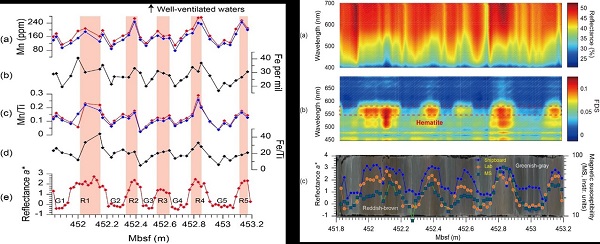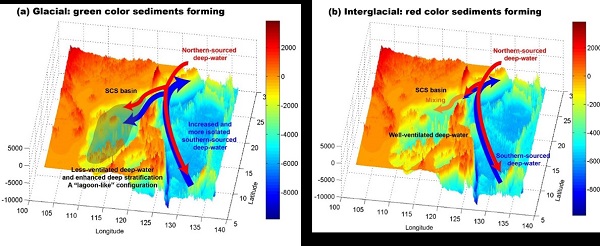The surface and deep waters of the Philippine Sea flow into the South China Sea(SCS), and the Intermediate Water of the SCS into the Philippine Sea through the Luzon Strait, which shows a vertical "sandwich" structure from the surface to the bottom in the northeastern SCS. The studies about Benthic foraminferal and ostracodal have disclosed the late Pleistocene evolution of the deep water mass and ventilation in the SCS, which have provided important information of the paleo-environment. However, on the long-term scale, few dada was acquired from the SCS deep-water, especially for the water mass history before the final formation of the modern tectonic structure during the Miocene.
During International Ocean Discovery Program (IODP) Expedition 367/368 in the northern SCS, the remarkable rhythmic reddish-brown and greenish-gray sediments were found during the Middle-Late Micoene, which provide valuable material to study the deep water property and its exchange with those of the Pacific Ocean.
Professor LI Baohua from Nanjing institute of Geology and Palaeontology, Chinese Academy of Sciences (NIGPAS), Dr. JIN Xiaobo, Professor LIU Chuanlian and others from Tongji University conducted experiments on the 442-497m sediment at site U1502 (water depth 3764m) through dealing with the sediment color reflectance, nannofossil composition, key element content, and clay minerals to determine the origin of these cyclicity-like color transitions during the late Miocene. The above result was recently published in Marine Geology:
It is inferred that the in-situ formed amorphous hematite caused the coloration of the reddish sediments, in which ferrum and manganese contents were high and carbonate was not poorly preserved. Therefore, the occurrence of the cyclicity-like color transitions reflects the extent of deep-water ventilation in the abyssal SCS. Such changes in deep-water ventilation were possibly related to an orbital-forced rearrangement of deep oceanic circulation in the Pacific Ocean.
A well-ventilated bottom water and less- preserved carbonate in these reddish sediments was proposed to be contributed by the stronger mixing of the northern- and southern-sourced deep-water during the interglacial period. While, during the glacial period, when the Antarctic ice sheet expanded, the formation of the Antarctic deep-water was enhanced and resulted in a more isolated and intensified deep stratification of the abyssal water masses in the SCS, forming the green colored sediments.
This study also provides important informations on the formation, evolution and environmental influence of the SCS.
This study was supported by the National Natural Science Foundation of China, the National Science and Technology Major Project of the Ministry of Science and Technology of China, and the Strategic Priority Research Program of the Chinese Academy of Sciences.
Reference: Jin, Xiaobo, Xu, Juan, Li, Yanli, Qiao, Peijun, Wu, Li, Ling, Cheng, Li, Baohua*, Liu, Chuanlian*, 2020. Origin of the rhythmic reddish-brown and greenish-gray sediments in the abyssal South China Sea: Implications for oceanic circulation in the late Miocene. 430: 106378. https://doi.org/10.1016/j.margeo.2020.106378.

Manganese and ferrum contents, magnetic susceptibility and sediment color reflectance a* at Site U1502A

Schematic deep-water ventilation in the (SCS) and the Pacific deep oceanic circulation during the glacial/interglacial cycles
